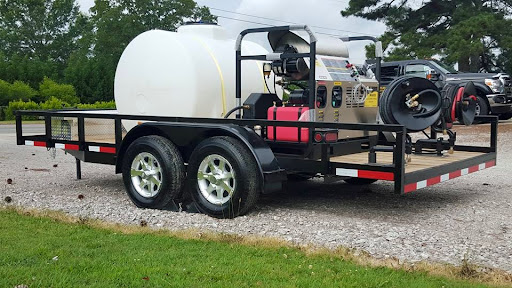
If you’re serious about launching a power washing business, one of the most important investments you’ll make is in your mobile setup. Whether you opt for a trailer, a van, or even a pickup truck bed, how you organize your rig will determine your efficiency, professionalism, and ability to scale. 🚚💨
This article will walk you through everything you need to know to set up your first power washing trailer or van—from equipment selection to layout tips—so you can hit the road ready to clean and impress. 🧼✅
🚐 Trailer vs. Van: Which One Is Right for You?
The first decision is whether you want to go with a utility trailer, a cargo van, or even a truck bed rig. Each has pros and cons:
| Option | Pros | Cons |
|---|---|---|
| Open Trailer | Easy to access, modular, expandable | Exposed to elements, takes up more space |
| Enclosed Trailer | Secure, protected from weather, clean appearance | Heavier, can be harder to access equipment |
| Cargo Van | Compact, mobile, secure | Limited space, harder to ventilate |
| Truck Bed Rig | Great for solo ops, quick access | No room for storage or future expansion |
If you’re just starting out, a 5×10 or 6×12 open trailer is a popular and cost-effective choice. Enclosed trailers offer better protection but come at a higher price.
🧰 Essential Equipment for a Power Washing Rig
No matter which vehicle setup you choose, your mobile rig should include the following core components:
🧽 Pressure Washer
- Commercial grade, at least 4 GPM / 3,500 PSI
- Gas-powered preferred for mobility
- Consider a belt-driven unit for longevity
💧 Water Tank
- 200 to 525 gallons is ideal
- Requires a buffer tank if your pressure washer outpaces the customer’s water supply
- Poly tanks are lightweight and durable
🔥 Hot Water System (optional)
- Necessary for grease, gum, oil stains, or commercial cleaning
- Typically mounted inline with the cold-water unit
🧯 Hose Reel System
- At least 100 feet of high-pressure hose
- Ideally mounted on swivel reels
- Include a separate garden hose reel for water supply
🧼 Chemical Tank(s)
- Designated tanks for bleach, degreaser, or surfactants
- Use proper plumbing and downstream injectors
⚙️ Other Accessories
- Surface cleaner (20-inch minimum)
- Extra spray tips and nozzles
- Wand extensions
- PPE (gloves, goggles, mask)
- Fire extinguisher
- Toolbox with spares
🧠 Pro Tip: Avoid overloading your trailer with unnecessary gear early on. Stick to the basics and expand as needed.
Browse Amazon Here For Power Washing Trailers And Equipment
🔧 Equipment Layout: Space and Workflow Matter
Efficient layout = less wasted time = more jobs per day = more money 💸
Here are some layout best practices:
- Mount pressure washer closest to the tailgate or door for easy servicing
- Place hose reels near the edge for fast deployment
- Water tank centered over the axle for weight balance
- Chemical tanks near the rear but shielded from sun exposure
- Surface cleaner mount on wall or under the rig if space allows
- Install shelving for chemicals, towels, and parts
Sketch out your rig layout before bolting anything down. You want to move left to right or front to back during setup and breakdown—no zigzagging!
🔋 Power and Drainage Considerations
⚡ Power:
Most gas-powered washers don’t need onboard electricity, but you may want a small generator for:
- Lighting inside enclosed trailers
- Electric hose reels
- Battery charging stations
🚿 Drainage:
Make sure your tanks are fitted with:
- Overflow shut-off valves
- Drain valves for quick emptying
- A filter system to catch debris
Proper drainage also helps with winterization and maintenance.
🔐 Security and Storage
If you’re parking your trailer or van outdoors overnight, theft becomes a real concern.
Secure your equipment with:
- Heavy-duty padlocks
- Trailer tongue locks
- Enclosed trailers with reinforced doors
- GPS trackers for vehicle/trailer recovery
- Visible branding—thieves don’t want attention
🧠 Insider tip: Keep serial numbers of all your equipment. Insurance claims go much smoother with proof of ownership.
🏷️ Branding and Presentation
Your mobile rig isn’t just a workspace—it’s a rolling billboard.
- Use high-quality vinyl graphics or magnets with:
- Business name
- Phone number
- Website and/or QR code
- Keep it clean and organized—your setup reflects your professionalism
- Consider adding a uniform look to your rig and your team’s attire
First impressions count, and a polished rig can win jobs before you even speak. 🎯
🧊 Weather-Proofing and Seasonal Prep
If you operate in cold climates, your rig must be ready for seasonal changes.
- Install a bypass loop or recirculation system to prevent freezing
- Keep antifreeze on hand during winter
- Use insulated covers or heat lamps in enclosed trailers
- Drain your water tanks and hoses every night during frost months
A frozen rig = no revenue. ❄️🛑
💸 Budget Breakdown for a Starter Mobile Setup
| Item | Estimated Cost |
|---|---|
| Pressure Washer (4 GPM, 3,500 PSI) | $1,200 – $2,000 |
| 225-Gallon Water Tank | $300 – $500 |
| Hose Reel System | $200 – $500 |
| Surface Cleaner | $400 – $800 |
| Trailer (5×10) | $1,000 – $2,000 |
| Miscellaneous Tools/Supplies | $500 – $1,000 |
Total Startup Cost: $3,600 – $6,800 (excluding vehicle)
🔚 Final Thoughts
Your mobile setup is the engine of your business—get it right, and you’ll be faster, more professional, and more profitable from day one.
Whether you’re starting with a small open trailer or building out a full enclosed rig, focus on function, safety, and visual impact. Don’t just copy someone else’s layout—design it for the services you offer and the way you work.
This setup will become your office, your warehouse, and your advertisement—all on wheels. 🚐🧽💼






